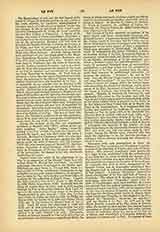

Leonard of Chios, b. at an uncertain date on the Island of Chios, then under Genoese domination; d. in Chios or in Italy, 1482. He himself says he was of humble parents. He entered the Dominican Order in Chios, and after profession was sent to Padua for his philosophical and theological studies. After ordination he taught at both Padua and Genoa, then at the request of Maria Justiniani returned to his native island, and was made Bishop of Mytilene on the island of Lesbos by Eugene IV. Emperor Constantine Palmologus had sent a request to the pope, asking that efforts be made to effect a union between the Latin and Greek Churches: for this purpose Leonard was selected to accompany Isidore, Cardinal–Bishop of Sabina, to Constantinople. Some degree of success was attained through their efforts, and a treaty was ratified in December, 1452. However, the Greeks refused the aid of the Latin troops, and in the following year Leonard was a witness to the devastation of the city by Mohammed II. Leonard and the cardinal were miraculously spared from the slaughter which ensued, the latter returning to Rome and Leonard to his diocese. From Chios he wrote to the pope a detailed account of the fall of Constantinople in a letter, which is often reprinted by historians (“Historia captae a Turcis Constantinopolis,” Nuremberg, 1544; P.G., CLIX, 923 sq.; Lonicer, “Chronica Turcica”, I, Frankfurt, 1578; “De capta a Mehemete II. Constantinopoli Leonardi Chiensis et Godefredi Langi narrationes,” ed. L’Ecuy, Paris, 1823). He governed his diocese for the next three years, until Lesbos also fell and he was taken captive to Constantinople. He obtained his freedom the following year, and immediately wrote the pope a description of the sack of his diocese (“Leonardi Chiensis de Lesbo a Turcis capta epistola Pio Papae II missa”, ed. Hopf, Konigsberg, 1866). His best-known writings are the two letters mentioned above and an apologetical tract in answer to the humanist Poggio. Both tracts with biographical sketches were edited by Michael Justinian (Avila, 1657). There is reason to believe that many of his letters remain unedited in the Vatican Library.
IGNATIUS SMITH

